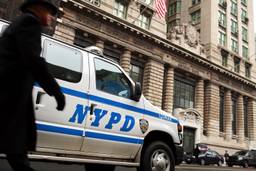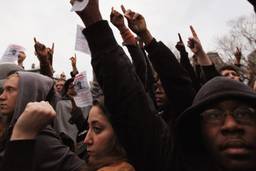President Obama has always prided himself on his perhaps illusionary ability to bridge the divide between left and right thereby bring the country together in the spirit of bipartisanship. But as Americans focused on whether or not Obama could successfully get Democrats and Republicans to sit at the same lunchroom table without a food fight breaking out, their country continued to fall apart in a different way as a deeper, far more serious rift between the rich and poor widened.
Occupy Wall Street has been extremely successful at spotlighting certain aspects of our society that are absurd or unjust. For example, the oppressive nature of the NYPD, vanishing First Amendment rights, the acquisition of public land by private companies, to name only a few. But there is another creepy reality that OWS has underlined, namely the partitioning of America into the “haves” and the “have-nots.”
For the past few decades, wealthy Americans have been withdrawing from mainstream society into their gated communities, complete with private security details. In the city, the privileged elite have their own version of these suburban fortresses, but instead of steel gates, they have a private army called the NYPD.
Yesterday, the NYPD closed down the block on which Mayor Bloomberg’s swank Upper East side townhouse resides, not because of a bomb threat or anything that serious, but because protesters had planned to set up a drum circle outside his home in protest.
Some media has been calling this Bloomberg’s “townhouse,” but that’s misleading. He has been busy buying up space in the building next door, and knocking down walls in order to combine the floor space. The New York Times estimates the renovations would fetch more than $30 million.
Bloomberg, the twelfth richest man in America, used the NYPD as his personal army to needlessly squash the planned protest even though, lost in the lavish space of his “Winchester House,” he probably wouldn’t have even heard the chanting.
The mayor’s home serves as a metaphor for the image he’s been desperately trying to carve out for himself. From the outside, sure, his home looks like a regular, albeit still expensive, townhouse. On the inside, however, the opulent living space is a perfect reflection of the one percent, just as Bloomberg, the billionaire, can never become a regular Joe simply because he occasionally rides the subway.
There’s something far creepier about the fact that, unlike his cohorts who openly display their fortunes by purchasing sprawling mansions shielded with imposing gates, Bloomberg’s annex occurred behind a protective wall as he bought and consumed living space that could have gone to housing other families. New York City isn’t able to facilitate rows of suburban castles so the rich cannibalize the innards of the city, consuming from the inside, out.
Crushing the harmless drum circle was a natural extension of how the NYPD has been used to date. JPMorgan Chase donated $4.6 million to the NYPD to “strengthen security in the Big Apple,” and a few months later, the force arrested over 700 individuals, who were protesting the fact that “banks got bailed out,” while “we got sold out,” in one of the largest mass arrests in the country’s history.
The wealthy are terrified of movements like OWS, which is why a well-known Washington lobbying firm with links to the financial industry proposed a $850,000 plan to smear the activists, or as they put it, “opposition research” in order to construct “negative narratives.”
This same fear may have motivated New York City’s mayor to engage in some seriously weird security theatre last night when he, along with Police Commissioner Ray Kelly, reenacted what an alleged “lone wolf” terrorist’s bomb might have looked like had it exploded. Such a demonstration was completely unnecessary, unless of course the mayor, who has been criticized for his overzealous use of the NYPD and abuse of Occupy protesters, wanted to remind everyone why he should possess unchecked power.
A side-note on the bizarre Bloomberg press conference: I found several aspects of the presser strange: First, the “lone wolf” vs. “Al-Qaeda” narrative. Bloomberg seemed to attempt to portray the alleged terrorist as both a solitary individual working on a crazed plan and also a piece of the larger Al-Qaeda network, which should totally freak everybody out.
Second, the OMFG scheduling of a presser on a Sunday night. Kelly mentioned that the NYPD had been tailing Jose Pimentel for two years, and for whatever reason, chose the week following Bloomberg’s PR disaster in the wake of raiding the park and forcing out journalists to make the bust.
Finally, Kelly said that federal agents were consulted, but the presser was definitely presented as an NYPD show.
So basically we have a story of a lone wolf almost-terrorist who talked some shit about Al-Qaeda, who authorities had in their scope for two years, and the NYPD took down on their own without any significant help from the feds, and this was important enough to issue a BREAKING REPORT Sunday night.
Maybe Bloomberg and Kelly did think this was super important, but the bust also serves as useful security theater to remind New Yorkers they should be completely panicked all the time, and let Bloomberg and the NYPD do whatever they need to do to keep us all safe.
Nowhere are the lines between the “haves” and “have-nots” clearer than the financial district. Lately, the NYPD has the perimeter around Wall Street completely sealed off, and one can only gain access to the heart of the area if one carries the correct company-issued ID card. The presence of this mini-gated community has not only infuriated the “have-nots,” but also local residents.
“My biggest issue is the barricades,” local resident Sabrina Espinal was quoted as saying by the Tribeca Trib. “I don’t care if they [the protesters] stay in that park ‘til kingdom come. I just want the barricades down.” When Metro asked Wall Street workers about fencing, they heard much the same. “I hate the barricades. It’s like we’re caged in,” said Janice Weinman, a 38-year-old hospitality worker on Wall Street. “They have to give us our sidewalk back.”
A recent poll conducted by the Siena Research Institute pre-raid reported that a majority of New Yorkers think the OWS protesters should be allowed in the park 24-hours a day. Meanwhile, Bloomberg’s popularity is fading, and Republicans and Democrats agree the mayor has lost his focus, or perhaps that he’s focused on the wrong things.
As some wealthy politicians vote to cut programs intended to help the poor, they are simultaneously withdrawing into their guarded enclaves, whether these dominions be located in suburbs or the Upper East side, so they won’t ever be forced to confront the consequences of their actions.
When the non-one-percenters attempt to present that reality, the NYPD rushes in to break things up. And just when it seems hordes of voters are tiring of the King Bloomberg act, surprise-surprise, another bad guy comes along to be paraded around by the NYPD as proof of why the city’s police state is so very necessary.




